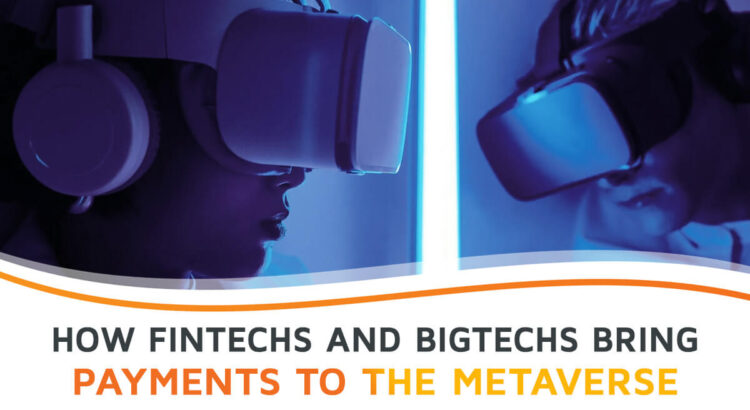
The Metaverse has been one of the hottest topics in business and tech in the last few months. Is this only a buzzword and a hype or does it have a real longer-term potential to become the “next big thing”? You can find supporters for both opinions. However, a lot of big consultancy companies believe that there is no way to fail for the Metaverse.
For example, according to CB Insights “the metaverse could represent a $1T market by the end of the decade”. Deloitte has published a white paper about the potential of the Metaverse and they believe in even higher numbers: “The metaverse may become a paradigm shift for consumer and enterprise behavior, analogous to the introduction of smartphones. It could create a potentially massive new market, with recent estimates of the commercial opportunity as high as $13 trillion and five billion regular users by 2030.” Accenture has launched the Accenture Metaverse Continuum business group to help their clients to understand and make use of the Metaverse opportunities. Its head Paul Daugherty stated that “The next generation of the internet is unfolding and will drive a new wave of digital transformation far greater than what we’ve seen to date, transforming the way we all live and work”.
I’m also rather on the optimistic side of supporters believing that Metaverse is not the hype but a next step in the technological, social and economical development of mankind.
However, before we analyze the current development status and prospects of the Metaverse, paying special attention to the payment topics, let’s review what “Metaverse” actually means and how it is different from “Web 3.0”.
What Does “Metaverse” Mean?
The term Metaverse (Meta + Universe) was introduced by Neal Stephenson in his 1992 novel “Snow Crash”. The Metaverse of Stephenson is an urban virtual world, to which the users have access via their own private or public terminals and appear there in the form of avatars. Neal Stephenson was not the only one who wrote down his vision about the future of virtual reality in the form of a literary work. There are other examples like the science fiction tetralogy “Otherland” (1996-2001) by Tad Williams or “Ready Player One” (2011) by Ernest Cline (all of them worth reading).
Probably one of those novels inspired the creators of the virtual reality project “Second Life”. What was a science fiction novel in 1992 became a reality in 2003. The users of “Second Life” can create avatars which interact with places, objects and each other like in the real world: they can build, create and trade virtual property and services. Of course, “Second Life” is not the very first virtual environment platform. The roots of virtual reality lie in the gaming industry and are much older than the “Second Life”. Just to give you some more recent Metaverse project examples one should mention modern platforms and games like Decentraland, Sandbox, Roblox, Fortnite or World of Warcraft.
There is no single definition of Metaverse, though most people agree that Metaverse is a concept, an idea, a vision. It’s not a concrete technology or product, not a single platform or company (so no, Meta isn’t the owner of the Metaverse and doesn’t have exclusive rights to use this term). The Metaverse allows people to embed 3D virtual worlds into their real life, combining the ideas of virtual reality and digital second life. It won’t likely completely replace real life, it will create an extended reality, where the people “live” in both worlds getting the best experiences of both.
How is Metaverse different from Web 3.0?
Sometimes the term “Metaverse” is mixed up and used interchangeably with Web 3.0. But they are not synonyms. Web 3.0 is basically the next generation of internet architecture. We expect it to be decentralized (based on blockchain or other peer-to-peer technologies unlike the server-client-based Web 2.0), and we expect it to be data- and privacy-centric, where the user decides what data he would like to share with whom, when and how.
There is also another important aspect of Web 3.0: The creation of highly personalized experiences for the user using automated content filtering through AI-driven applications and also more immersive and interactive media. It’s hard to define a distinct boundary between both concepts as the Metaverse may use Web 3.0 technologies to build their new virtual worlds. And those virtual worlds can be seen as the new way of delivering content in Web 3.0. So let’s say these 2 terms are interconnected, related to each other but not equal.
What Are the Building Blocks of the Metaverse?
So we just ascertained that Metaverse is offering users a possibility to integrate virtual reality into the real world, their daily life. The purpose of using it may be different, it may have a gaming character, it may help to fulfill some daily life tasks (like shopping), it may provide new ways of businesses and for the work collaboration (visiting conferences, meeting with customers or colleagues) or it may offer new opportunities how to spend your spare time (visiting concerts or museums, traveling). So it’s an extension of the real world that has no physical limits, only technological ones.
The Metaverse can combine and offer thousands of virtual worlds with their own products, goods and services. But can we bring more structure into this concept to make it more tangible? Can we identify some areas, layers and components of the Metaverse?
In an article about the Metaverse and its impact on the financial space VISA defines 4 big areas:
- Augmented reality
- Lifelogging
- Mirror worlds
- Virtual worlds
CBInsights identifies the following layers of the Metaverse:
- infrastructure (network and computing)
- access (hardware)
- visualization tools
- virtual worlds
- economic infrastructure (payments, NFT, crypto wallets, crypto exchanges)
- experiences
CBInsights has also provided a nice overview of the companies that are building products for every layer of the Metaverse.
As we are a software provider for online payment and e-wallet-based systems, I am mostly interested in the economical aspects of the Metaverse, with a special focus on the payment area.
How Will the Metaverse Impact Ways of Payment
Like in the real world or on the current online platforms of Web 2.0 in the Metaverse people will need to be able to pay for goods and services. The interesting questions are: how will it be shaped and who will be the big players there?
From my point of view the most important aspects of the “how” are:
- Will there be decentralized or centralized payments? And related to it, will we use rather fiat money, virtual (Metaverse world specific) or cryptocurrencies?
- How interoperable will the payment systems be? Will they be usable in every Metaverse world or will every Metaverse world offer its own payment infrastructure and payment methods?
It’s hard to predict the direction with confidence. I personally believe that systems based on decentralized technologies, which will be the backbone for Web 3.0 and which were designed for the digital world unlike the traditional financial systems, will get a significant share in the Metaverse. Looking at the famous Metaverse projects like Decentraland or The Sandbox we see that they are built on decentralized technologies and use their own “in-game” currencies in their virtual economies.
And the ways of how we pay – and what payment instrument we use – should also noticeably change considering what we’ve said above about the importance of personal data ownership and privacy. I’ve already shared some thoughts about a possible solution (“pay by identity”) assuming that most people would be willing to give their data in exchange for a comfortable way to pay. But I might also be wrong and people will learn to pay more attention to privacy and take more care of their personal data. In this case, cryptocurrencies may become more and more important not only in the investment area but also as means of payment.
And last but not least the interoperability of different payment solutions will be key to making customer payments seamless and convenient. And that’s another challenge to be solved and another question to be answered on the long list of uncertainties around the Metaverse.
What Do Big Tech and Payment Players Do?
Let’s have a look at the movements and financial plans of some tech giants and famous payment providers, some of which have entire innovation departments working on the hot Metaverse topic. How do they prepare for the future?
Meta
Meta (formerly known as Facebook) is of course looking into this topic, that’s exactly the reason for their renaming. They want to participate on different levels and layers. In terms of payment, they announced recently that they want to enable their Meta Pay wallet for the Metaverse. Mark Zuckerberg said in the official posting on 22.06.2022: “… we’re working on something new: a wallet for the metaverse that lets you securely manage your identity, what you own, and how you pay.” It’s not yet clear how exactly they would like to build it, e.g. whether it will be implemented with a decentralized or centralized approach. However they are aware of the importance of interoperability: “Ideally, you should be able to sign into any metaverse experience and everything you’ve bought should be right there.”
With its Google Glasses launched in 2013, the company was one of the first big players offering a solution for the Mixed or Augmented Reality. Unfortunately, high price and data privacy issues prevented them from breaking through. Further VR, AR and related AI projects followed: Cardboard, Daydream platform, Google Lens and others. There is a rumor that they will bring a new generation of Google Glasses on the market soon.
With regards to payments, there is no clarity about the strategy of Google. On the one hand, the Google Pay project didn’t get much traction when compared to its rival Apple Pay and the tech giant declared to cancel its plans to become a bank. On the other hand, Google is building a new division for “blockchain and other next-gen distributed computing and data storage technologies” and cooperates with crypto firms including Coinbase and BitPay to add crypto payment capabilities to its digital debit cards. And at the beginning of 2022 Google has hired Arnold Goldberg, former senior vice president and chief product architect at PayPal, to lead its payments business. So I’m looking forward to getting announcements of the Google strategy on payment product development for the Metaverse.
Microsoft
Microsoft is one of the tech giants that engaged in the Metaverse before it was actually called “Metaverse”. Microsoft is focusing more on business applications and use cases. E.g. as early as 2016 they’ve introduced the product concepts of Microsoft HoloLens, a Merged-Reality-Glasses, and Holoportation, an application for HoloLens allowing you to see your remote meeting partner as a hologram in the room. They’ve also launched Mesh, a mixed-reality solution for their remote collaboration tool Microsoft Teams.
At the beginning of this year, Microsoft made the largest acquisition in its history: they paid 69 Billion USD for the gaming company Activision Blizzard, and the word “Metaverse” was the main reason for this deal, in Microsoft’s own explanation.
Recently Microsoft has published a blog article about the importance of security, identity management and interoperability in the Metaverse. Thus we can assume that they are looking into these topics internally, too. Not so obvious are their plans to address the challenges of the payment world, so it’s not yet clear what the future of their Microsoft Financing solution will be or whether there are any ambitions to revive Microsoft Wallet.
Apple
There is a good article describing the AR hardware / AR headset plans of Apple (in German). For example, they’ve registered a patent for AR glasses that will be capturing not only the outside world but also the face (e.g. eye movements and facial expression) of the wearer. There are more patents for different AR hardware including a headset, which is expected to be launched already in 2022.
I haven’t found information about their vision for Apple Pay in the Metaverse though. I cannot imagine they are not looking into the payment options, thus I assume this info is just not yet available to the public.
PayPal
And what about PayPal, probably the world’s most known digital wallet-based payment system? Do they have objectives and a mission statement with regards to Metaverse? Don’t they want to become THE wallet which is used on each and every Metaverse platform?
Well, PayPal has recently launched a super app, allowing their customers to buy, sell and hold cryptocurrencies. PayPal not only wants to offer trading for different main cryptocurrencies or crypto payment support, but they also look into other topics like issuing their own stablecoin. And as we’ve seen, blockchain technologies and cryptocurrencies are a fundamental component of Web 3.0 which will be the backbone of the Metaverse. So it suggests that PayPal is evaluating the Metaverse opportunities and will try to secure its place there.
Stripe
Similar to PayPal, Stripe is now (again) involved in the crypto business. Since the beginning of this year, they support crypto businesses like exchanges, NFT marketplaces and also other DeFi products providers with a toolkit, offering fiat payments API integration to process crypto-to-fiat currency payments. This is the first big move by Stripe after they’ve announced the creation of a crypto team to prepare for Web 3.0 payments back in October 2021. One can be curious about what steps will follow.
MasterCard
MasterCard seems to have big plans to break into the Metaverse market as they’ve registered 15 trademarks for payment processing / virtual cards, marketplaces for digital goods and NFTs, events and performances and online communities and all this in the Metaverse. So they definitely want to get their piece of the Metaverse payment cake.
VISA
VISA doesn’t really reveal its own strategy yet, but beyond any doubt, they are looking into this area, as they’ve analyzed current trends and published a white paper advising financial institutions on how to prepare for the Metaverse. And last year they spent $150,000 to buy a Crypto Punk NFT which is considered to be their first Metaverse deal.
Conclusion
Whether you like it or not: The Metaverse is already in the making. No matter in what shape exactly, it’s coming. So if you believe in the potential of the Metaverse, the time has arrived to prepare your business for it. There is a lot to do and many opportunities to join the party. Every company can participate in this trend and provide building blocks and applications for the Metaverse. Should you be interested in the economical aspects and should you be planning to develop any payment product: trimplement is here to make your vision happen!
Feel free to contact us any time.



